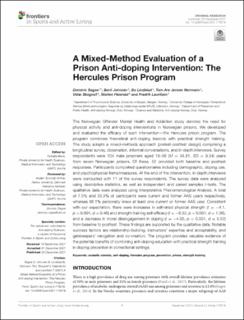| dc.contributor.author | Sagoe, Dominic | |
| dc.contributor.author | Berit, Johnsen | |
| dc.contributor.author | Lindblad, Bo | |
| dc.contributor.author | Norman, Tom Are Jensen | |
| dc.contributor.author | Skogvoll, Vidar | |
| dc.contributor.author | Heierdal, Morten | |
| dc.contributor.author | Lauritzen, Fredrik | |
| dc.date.accessioned | 2022-02-01T13:16:34Z | |
| dc.date.available | 2022-02-01T13:16:34Z | |
| dc.date.created | 2021-12-17T20:05:36Z | |
| dc.date.issued | 2021 | |
| dc.identifier.issn | 2624-9367 | |
| dc.identifier.uri | https://hdl.handle.net/11250/2976294 | |
| dc.description.abstract | The Norwegian Offender Mental Health and Addiction study denotes the need for physical activity and anti-doping interventions in Norwegian prisons. We developed and evaluated the efficacy of such intervention—the Hercules prison program. The program combines theoretical anti-doping lessons with practical strength training. The study adopts a mixed-methods approach (pretest-posttest design) comprising a longitudinal survey, observation, informal conversations, and in-depth interviews. Survey respondents were 104 male prisoners aged 18–56 (M = 34.81, SD = 9.34) years from seven Norwegian prisons. Of these, 52 provided both baseline and posttest responses. Participants completed questionnaires including demographic, doping use, and psychophysical items/measures. At the end of the intervention, in-depth interviews were conducted with 11 of the survey respondents. The survey data were analyzed using descriptive statistics, as well as independent and paired samples t-tests. The qualitative data were analyzed using Interpretative Phenomenological Analysis. A total of 7.5% and 33.3% of participants were current and former AAS users respectively, whereas 86.1% personally knew at least one current or former AAS user. Consistent with our expectation, there were increases in self-rated physical strength (t = −4.1, p < 0.001, d = 0.46) and strength training self-efficacy (t = −8.33, p < 0.001, d = 1.36), and a decrease in moral disengagement in doping (t = −4.05, p < 0.001, d = 0.52) from baseline to posttest. These findings are supported by the qualitative data. Notable success factors are relationship-building, instructors' expertise and acceptability, and gatekeepers' navigation and co-creation. The program provides valuable evidence of the potential benefits of combining anti-doping education with practical strength training in doping prevention in correctional settings. | en_US |
| dc.language.iso | eng | en_US |
| dc.publisher | Frontiers Media | en_US |
| dc.rights | Navngivelse 4.0 Internasjonal | * |
| dc.rights.uri | http://creativecommons.org/licenses/by/4.0/deed.no | * |
| dc.title | A Mixed-Method Evaluation of a Prison Anti-doping Intervention: The Hercules Prison Program | en_US |
| dc.type | Journal article | en_US |
| dc.type | Peer reviewed | en_US |
| dc.description.version | publishedVersion | en_US |
| dc.rights.holder | Copyright 2021 Sagoe, Johnsen, Lindblad, Normann, Skogvoll, Heierdal and Lauritzen | en_US |
| dc.source.articlenumber | 779218 | en_US |
| cristin.ispublished | true | |
| cristin.fulltext | original | |
| cristin.qualitycode | 1 | |
| dc.identifier.doi | 10.3389/fspor.2021.779218 | |
| dc.identifier.cristin | 1970131 | |
| dc.source.journal | Frontiers in Sports and Active Living | en_US |
| dc.identifier.citation | Frontiers in Sports and Active Living. 2021, 3, 779218. | en_US |
| dc.source.volume | 3 | en_US |

